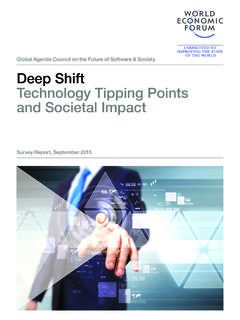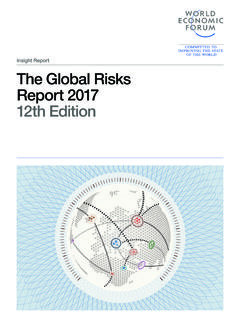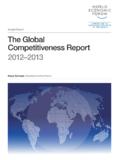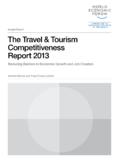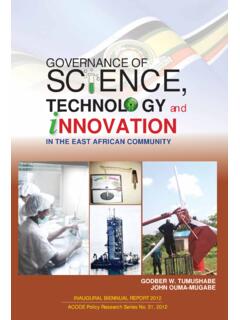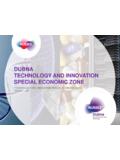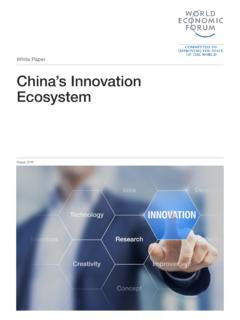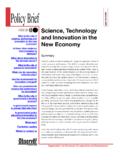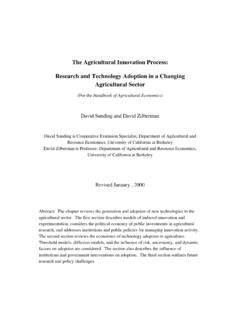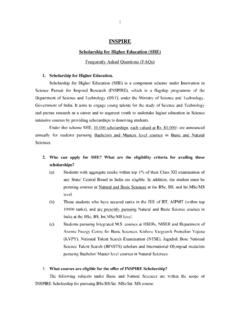Transcription of System Initiative on Shaping the Future of Food …
1 innovation with a Purpose:The role of technology innovation in accelerating food systems transformationJanuary 2018 System Initiative on Shaping the Future of Food Security and AgriculturePrepared in collaboration with McKinsey & CompanyINCLUSIVITYSUSTAINABILITYEFFICIEN CYNUTRITION AND HEALTHI nnovation with a Purpose2 World Economic Forum 2018 All rights part of this publication may be reproduced orTransmitted in any form or by any means, including Photocopying and recording, or by any information Storage and retrieval in technology as well as policy, financing and business models are essential to nourish the world in a safe, responsible and sustainable way. To improve global food security and nutrition, different players and stakeholders must come together to acknowledge gaps and share approaches for addressing them. We have an incredible opportunity to work together to use technology and innovation to create more inclusive and sustainable food W.
2 MacLennanChairman and Chief Executive Officer, Cargill technology has the potential to answer some of our biggest questions and help us better understand the world around us. In almost every industry, massive efforts are underway to connect our physical and digital worlds, unleashing the Fourth Industrial Revolution. We must work together to ensure that the food and agriculture sector is not left behind and that these efforts contribute towards global food systems that benefit farmers, consumers and the MeyersonChief innovation Officer, IBM Corporation Rajiv Shah President of the Rockefeller Foundation A new revolution in food has the potential to create healthy food systems that sustain our families and our planet. We have the tools and technology to create innovations that could expand dignity and justice to vulnerable populations. To this end, we must continue to build the shared capacity of businesses and philanthropies, faith institutions and state and local governments to come together to try to solve the world s toughest SungaChief Executive Officer, Southern African Confederation of Agricultural Unions (SACAU) Smallholder farmers produce 80% of Africa s food supplies, but they have limited access to finance, inputs, markets, information and other services.
3 technology innovations can overcome all these challenges but it won t happen automatically. We need to combine innovation , investment and policy to harness the power of the Fourth Industrial Revolution to benefit smallholder LambertiniDirector General of WWF International Food today generates a heavy environmental footprint. A shift to sustainable food systems is essential and includes: sustainable production and harvest on land and at sea, integrated land-use planning, land and marine restoration, reducing food loss and waste, and shifting to low footprint diets. To achieve this we need progressive regulation, smart land-use governance, technology innovation , behavioural change and multi-stakeholder collaboration. innovation with a Purpose32 Quotes3 Preface4 Executive summary6 The need for global food systems transformation9 The power of technologies in transforming food systems11 Exploring the power of the Transformative Twelve 27 Scaling technology innovations31 Conclusion32 Annex: Methodology notes36 Acknowledgements39 Endnotes and referenesContentsPrefaceSarita NayyarChief Operating OfficerWorld Economic Forum LLCSean de Cleene Head of Food Security and Agriculture InitiativesWorld Economic ForumLisa DreierSenior Advisor, Food Security and Agriculture InitiativesWorld Economic Forum LLCBy 2050, global food systems will need to sustainably and nutritiously feed more than 9 billion people while providing economic opportunities in both rural and urban communities.
4 Yet our food systems are falling far short of these goals. A systemic transformation is needed at an unprecedented speed and scale. At the same time, the Fourth Industrial Revolution is driving disruptive technology innovations across many sectors. Agriculture and food systems have been slow to benefit from these developments the sector lags significantly behind in harnessing the power of technology and making it widely accessible. This report aims to identify emerging technology innovations that have the potential to drive rapid progress in the sustainability, inclusivity, efficiency and health impacts of food systems to achieve the Sustainable Development Goals. It highlights the significant economic, environmental and health benefits that could be realized through the broad adoption of certain technologies and enabling actions that can support and scale them. It recognizes that technology is just one of a wide range of solutions that need to be applied in tandem to transform food systems and that a systems leadership approach is needed to engage all stakeholders towards that shared innovation with a Purpose project forms part of the World Economic Forum s System Initiative on Shaping the Future of Food Security and Agriculture.
5 The Initiative is one of 14 major global programmes to drive systemic change in response to complex global challenges. The Initiative engages over 650 organizations in Shaping a common agenda for food systems transformation and mobilizing 21 countries through partnerships catalysed by the New Vision for Agriculture (NVA) Initiative . The NVA is driven by ministers, CEOs, farmer leaders, civil society, international organization leaders and other key stakeholders collaborating on over 100 value-chain projects in Africa, Asia and Latin America. We hope that the technology applications explored in this report and the innovation ecosystems that enable them will prove useful to leaders seeking to drive accelerated progress and innovation on the report was developed in partnership with McKinsey & Company, led by Sunil Sanghvi, Pradeep Prabhala, Marla Capozzi, Joshua Katz and Antonin Picou. At the Forum, the project was led by Lisa Dreier, Saswati Bora and Caitlin O Donnell with input from Sean de Cleene, Tania Strauss, Jim Riordan, Maria Elena Varas and Christian Kaufholz.
6 Members of the World Economic Forum s Global Future Council on Food Security and Agriculture, as well as other leading experts and technology innovators (listed in the Annex) provided substantial input. We also gratefully acknowledge the support of the Government of the Netherlands, Global Affairs Canada, the Rockefeller Foundation and the Wellcome Trust in funding our System Initiative , including work on this with a Purpose4 The need to transform food systemsGlobal food systems today are in need of transformation. Billions of people are poorly nourished, millions of farmers live at subsistence level, enormous amounts of food go to waste and poor farming practices are taking a toll on the environment. Achieving the Sustainable Development Goals (SDGs) by 2030 will require food systems that are inclusive, sustainable, efficient, nutritious and healthy. Achieving a true transformation of food systems requires a holistic approach one engaging all stakeholders and deploying a wide array of actions such as improved policy, increased investment, expanded infrastructure, farmer capacity-building, consumer behaviour change and improved resource management.
7 technology innovations, combined with other interventions, can play an important role in enabling and accelerating food systems innovation for food systems: emerging opportunitiesEmerging technologies driven by the Fourth Industrial Revolution are disrupting many industries, bringing rapid and large-scale change. These include: Digital building blocks such as big data, the Internet of Things (IoT), artificial intelligence and machine learning and blockchain New physical systems such as autonomous vehicles, advanced robotics, additive manufacturing, advanced materials and nanotechnologies Advances in science such as next-generation biotechnologies and genomics, and new energy technologiesUntil now, the food and agriculture sectors have been slow to harness the power of these technologies, attracting significantly lower levels of investment and inspiring fewer technology start-ups than other sectors. Our research revealed $14 billion in investments in 1,000 food systems-focused start-ups since 2010, while healthcare attracted $145 billion in investment in 18,000 start-ups during the same time Executive summaryWith the right enabling actions we can harness the power of technology innovation to help transform global food TRACEABILITY Reduce food loss by up to 30 million tonnesNUTRIGENETICSFOR PERSONALIZED NUTRITION Reduce the number of overweight by up to 55millionIOT FOR REAL-TIME SUPPLY CHAIN TRANSPARENCY AND TRACEABILITY Reduce food loss by up to 35 million tonnesMICROBIOME TECHNOLOGIES TO ENHANCECROPRESILIENCE Generate up to $100 billion in additional farmer income Increase production by up to 250 million tonnes Reduce GhGemissions by up to 30 megatonnesof PROTEINS Reduce GhGemissions by up to 950 megatonnesof CO2eq.
8 Reduce freshwater withdrawals by up to 400 billion cubic metres Liberate up to 400 million hectares of land4. Marketplace1. Payments3. Supply chain information2. Farm informationMOBILE SERVICE DELIVERY Generate up to $200 billion of income for farmers Reduce GhGemissions by up to 100 megatonnesof CO2eq. Reduce freshwater withdrawals by up to 100 billion cubic metresBIOLOGICAL-BASED CROP PROTECTION AND MICRONUTRIENTS FOR SOIL MANAGEMENT Increase production by up to 50 million tonnes Reduce GhGemissions by up to 5 megatonnesof AGRICULTURE FOR INPUT AND WATER USE OPTIMIZATION Reduce farmers costs by up to $100 billion Increase production by up to 300 million tonnes Reduce freshwater withdrawals by up to 180 billion cubic metresFOOD SENSING TECHNOLOGIES FOR FOOD SAFETY, QUALITY, AND TRACEABILITY Reduce food waste by up to 20 million tonnesBIG DATA AND ADVANCED ANALYTICS FOR INSURANCE Generate up to $70 billion of income for farmers Increase production by up to 150 million tonnesOFF-GRID RENEWABLE ENERGY GENERATION AND STORAGE FOR ACCESS TO ELECTRICITY Generate up to $100 billion in additional farmer income Increase production by up to 530 million tonnes Reduce freshwater withdrawals by up to 250 billion cubic metresGENE-EDITING FOR MULTI-TRAIT SEED IMPROVEMENTS Generate up to $100 billion in additional farmer income Increase production by up to 400 million tonnes Reduce the number of micronutrient deficient by up to $100 millionChanging the shape of demandPromoting value-chain linkagesCreating effective production systemsFigure 1: The Transformative Twelve could deliver significant impacts to food systems by 2030 Figure 1.
9 The Transformative Twelve could deliver significant impacts to food systems by 2030 Changing the shape of demandPromoting value-chain linkagesInnovation with a Purpose5 The lower levels of investment in food systems are due in great part to the complexity of the sector. Fragmented rural markets, poor infrastructure, high regulatory burdens and other factors raise costs, while revenues are constrained by customers limited ability and willingness to pay. In addition, much of the food systems start-up activity is concentrated in developed countries and on improving the production landscape, indicating both the risk of unequal access to new solutions and the opportunities for scaling in developing countries and in demand-side innovations. Coordinated efforts by policy-makers, investors, educators and others to nurture and accelerate food systems enterprises in all regions can overcome those Transformative Twelve : Innovations with much potential in food systemsWe identified 12 technology applications that illustrate the potential of emerging opportunities in food systems including improving consumer nutrition, increasing supply-chain efficiency and transparency and boosting farmer productivity and profitability.
10 While many are in the early stages, the Transformative Twelve technologies could deliver significant positive impacts in food systems by 2030. Figure 1 illustrates the main impacts of each of the 12 applications of technology . Achieving this potential is not a given it will require key enablers including policy, investment, infrastructure and availability of complementary technologies. The broader impacts of these technologies, including the potential for unintended consequences, must also be continuous innovation The activity taking place around the Transformative Twelve technologies signals both growing momentum and rapid evolution in this area. Capitalizing upon and further developing the value of these and other technologies will require continuous innovation . By establishing innovation ecosystems designed to incentivize and accelerate technology innovation , communities can help develop a robust and competitive pipeline of solutions to Future food systems challenges.
